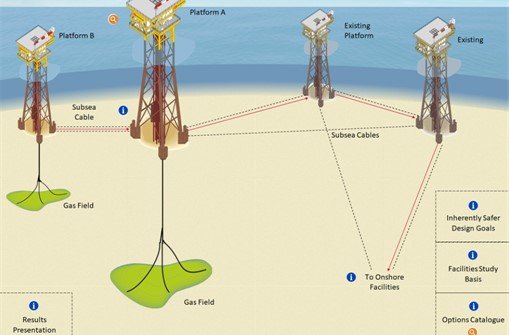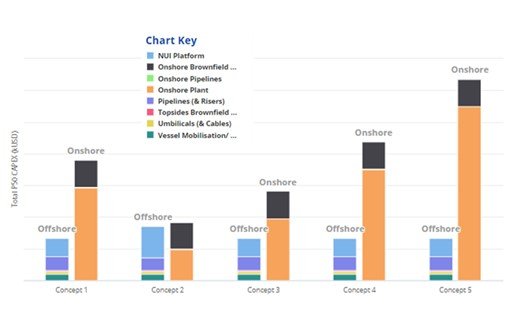CHALLENGE

A Concept Development Studies programme which consisted of four projects, aimed at reducing the CO2 footprint and ensuring that existing LNG trains are kept full with hydrocarbon feed.
With each project featuring 10-20 concepts and remote working restricting conventional interaction between client and project team, digital tools became vital for collaboration and for facilitating information and results sharing. At Genesis, we saw an opportunity to deploy our proprietary field development tool Ultra Front EndTM to meet this challenge.
The complex project scopes included new offshore production facilities and the implementation of onshore hydrocarbon compression to prolong the operating life of LNG facilities. Additionally, new CO2 compression and dehydration facilities were included in order to divert captured CO2 from onshore incineration to an offshore injection normally unattended installation (NUI) facility, thereby reducing overall CO2 emissions and enabling Enhanced Gas Recovery.
UNDERSTANDING
The challenges for Genesis were:
- Ensure that the client team had confidence in UFE and were able to use it to evaluate and compare concepts enabling better-informed decisions;
- Draw upon ADEPT and Advisory capabilities to generate concepts, equipment lists, cost estimates, and greenhouse gas (GHG) emissions estimates to develop robust concepts;
- Utilise UFE for results sharing to maximise the value-added for the client during a period of remote working.
SOLUTION
Genesis provided a ‘show and tell’ demonstration of UFE’s capabilities, sharing initial results and giving a virtual tour of the software to provide the client team with the best possible experience and understanding.

For each of the four projects, an individual UFE interface was developed; these were integrated together and with Microsoft Teams through the use of hyperlinks and visual prompts. Each UFE interface featured the following for all concepts:
- Visuals in the form of unique schematics, site maps, block flow diagrams, and concept lists. These allowed the client to rapidly gain an understanding of concepts;
- Additional concept information is provided through ‘info points’ and links to key documents as well as the option to directly download results;
- Cost estimates results presented as comparison charts and tables;
- Equipment lists produced via ADEPT were directly uploaded. UFE automatically converted the data into clear tables and graphics comparing weights for equipment, bulks, and where relevant jackets;
- GHG emissions, a key driver of this project, could be shared directly.
The client was granted access to the UFE projects once they were published, from which point they could compare results of individual concepts.
RESULTS
Through using UFE, there was potential for considerable time savings associated with the preparation of deliverables, allowing more resources to be spent on developing concepts into more robust, defined options. The nature of UFE allowed for the continuous development of ‘live’ results, allowing collaboration to continue across the wider project team and demonstrating Genesis’s commitment to agile working. Key results being in a common location, alongside concept visuals and descriptions, provide clarity and confidence to the decision-making process.
I love the way it (UFE) integrates different views and disciplines. It differentiates Genesis and is the way forward!
Get in touch
If you require more information, please contact your local Genesis representative.



